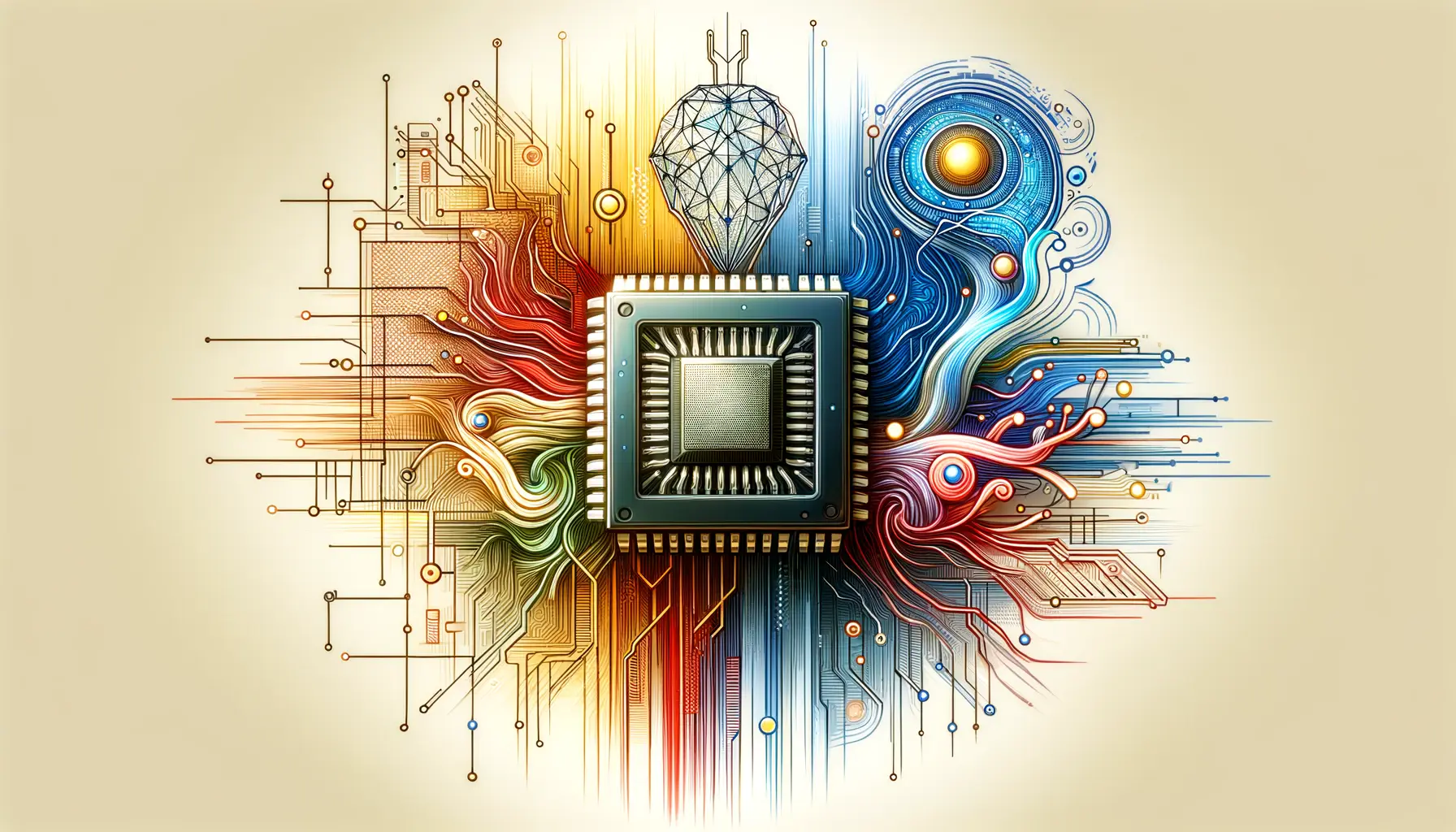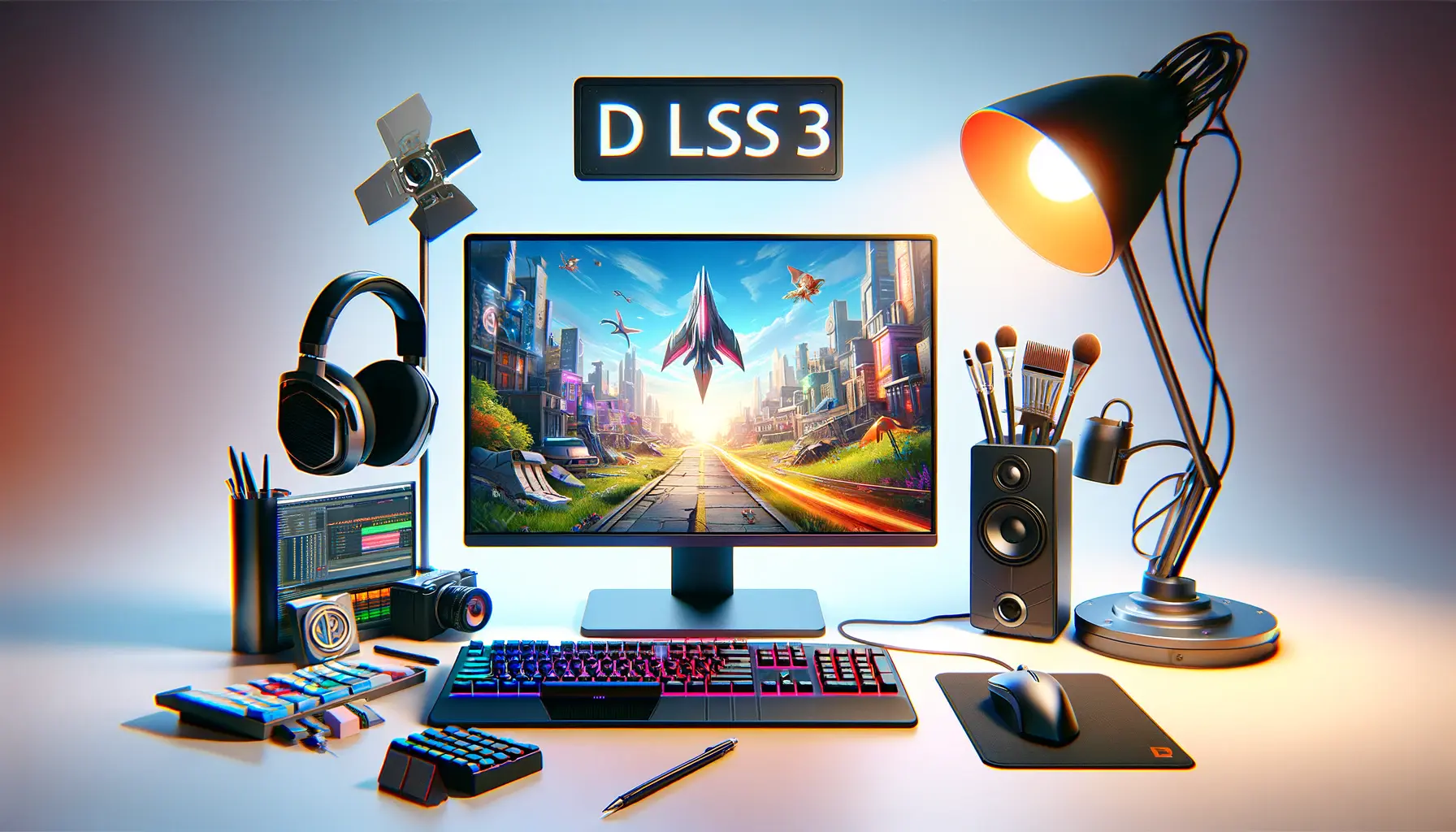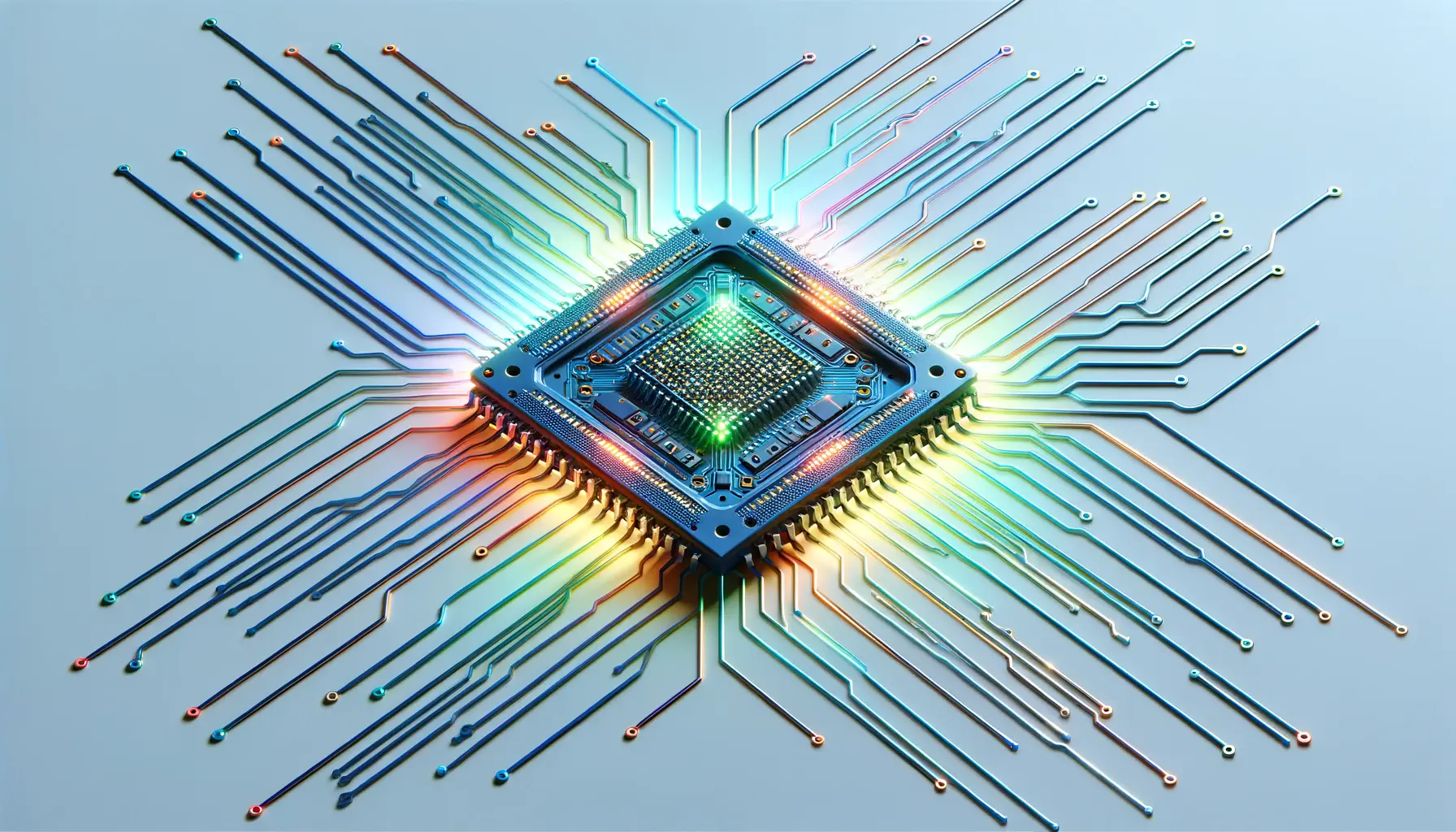The realm of gaming and graphical fidelity has been revolutionized with the advent of Deep Learning Super Sampling (DLSS) technology, particularly with its latest iteration, DLSS 3.
This groundbreaking technology, developed by NVIDIA, leverages artificial intelligence to enhance gaming visuals while simultaneously boosting performance, marking a significant leap in the pursuit of hyper-realistic and fluid gaming experiences.
At its core, the science behind DLSS 3’s AI revolves around deep learning algorithms and neural networks that have been meticulously trained on NVIDIA’s supercomputers.
These AI models are capable of generating high-quality images from lower-resolution inputs, ensuring that games not only look better but run smoother on less powerful hardware.
The implications of this technology extend beyond just gaming, hinting at a future where AI can drastically improve the efficiency and quality of visual content across various domains.
- Understanding DLSS Science
- Benefits of DLSS 3 for Gamers and Developers
- How DLSS 3 Enhances Gaming Realism
- Comparing DLSS 3 with Previous Versions
- DLSS 3’s Impact on Game Development
- Challenges and Considerations with DLSS 3
- Future Directions of AI in Gaming
- Embracing the Future with DLSS 3’s AI
- DLSS 3 AI: Frequently Asked Questions
Understanding DLSS Science
DLSS, or Deep Learning Super Sampling, is a novel rendering technology that utilizes the power of AI to interpolate images in real-time, enabling higher frame rates without compromising on visual quality.
This is achieved by rendering a game at a lower resolution and then using the DLSS AI algorithms to upscale the image to the desired output resolution.
The result is a game that looks as if it’s running at a higher resolution, but with the performance benefits of a lower one.
The evolution of DLSS technology has been rapid, with DLSS 3 representing the pinnacle of this development.
Unlike its predecessors, DLSS 3 introduces the concept of frame generation, where the AI predicts and inserts additional frames between existing ones to create a smoother gaming experience.
This not only improves frame rates but also reduces latency, making games feel more responsive.
AI and Frame Generation
The introduction of AI-driven frame generation in DLSS 3 is a testament to NVIDIA’s commitment to pushing the boundaries of gaming technology.
By analyzing two consecutive frames, the AI predicts the movement within the scene and generates intermediate frames.
This process, powered by the latest generation of NVIDIA RTX GPUs, significantly enhances fluidity in games, making fast-paced action and complex visual scenes more immersive and lifelike.
Moreover, DLSS 3’s AI is trained on a vast dataset of high-quality game footage, allowing it to understand and replicate intricate details and textures accurately.
This level of detail and precision ensures that the upscaled images maintain fidelity to the original content, preserving the artistic intent and immersive qualities of the game.
DLSS 3’s AI-driven frame generation represents a significant leap in gaming technology, offering both performance enhancements and improved visual fidelity.
Benefits of DLSS 3 for Gamers and Developers
The advent of DLSS 3 has brought about a myriad of benefits not only for gamers but also for game developers.
These advantages span from enhanced gaming experiences to new horizons in game development and design.
For Gamers
- Improved Frame Rates: One of the most immediate benefits of DLSS 3 is the significant boost in frame rates. By rendering games at a lower resolution and then upscaling, DLSS 3 allows gamers to enjoy their favorite titles at higher frame rates without needing to upgrade their hardware.
- Better Image Quality: DLSS 3 utilizes advanced AI algorithms to enhance image quality, ensuring that even when games are rendered at lower resolutions, the final image is crisp, clear, and devoid of artifacts typically associated with upscaling techniques.
- Reduced Latency: The frame generation technology in DLSS 3 not only improves smoothness and fluidity but also reduces input lag, making games more responsive and immersive.
For Developers
- Enhanced Creative Freedom: With DLSS 3, developers can push the boundaries of visual fidelity and complex game mechanics without being constrained by hardware limitations, allowing for more ambitious game designs.
- Optimized Performance: DLSS 3 offers developers the ability to optimize their games for a wide range of hardware, ensuring that more players can experience their games as intended, regardless of their system’s capabilities.
- Future-Proofing Titles: Integrating DLSS 3 technology allows developers to future-proof their titles, ensuring that their games remain visually stunning and performant on future hardware generations.
The dual benefits of DLSS 3 for both gamers and developers underscore its transformative impact on the gaming industry, heralding a new era of performance and visual quality.
How DLSS 3 Enhances Gaming Realism
DLSS 3’s impact on gaming realism is profound, offering an unparalleled level of detail and smoothness that significantly enhances the overall gaming experience.
This section delves into the mechanisms through which DLSS 3 achieves this feat and the implications for gaming realism.
Enhancing Visual Details
At the heart of DLSS 3’s ability to enhance gaming realism is its sophisticated AI-driven approach to image rendering.
By intelligently analyzing and upscaling images, DLSS 3 ensures that every frame is rich in detail and free from common upscaling artifacts like blurring or pixelation.
This results in a game world that is more immersive and realistic, where textures, lighting, and shadows are rendered with incredible precision.
Moreover, DLSS 3’s deep learning algorithms are continuously improved, meaning that the system gets better over time.
As NVIDIA’s neural networks are trained on a broader array of images and scenarios, the quality of the upscaling and frame generation only increases, further enhancing the realism of games.
Improving Motion Fluidity
Another aspect of gaming realism significantly impacted by DLSS 3 is motion fluidity.
Traditional rendering methods can often result in stuttering or lag, which breaks the immersion and realism of the gaming experience.
DLSS 3’s frame generation technology combats this by inserting additional frames between existing ones, smoothing out motion and making gameplay feel more natural and lifelike.
This improvement in motion fluidity is particularly noticeable in fast-paced games or scenes with a lot of action.
Gamers can enjoy seamless transitions and movements, contributing to a more engaging and realistic gaming experience.
- Increased detail and clarity in game visuals.
- More natural and fluid motion, enhancing the realism of game physics and character movements.
- Improved shadow and lighting effects, contributing to a more immersive game world.
DLSS 3’s advancements in enhancing visual details and improving motion fluidity are pivotal in pushing the boundaries of gaming realism, offering gamers an experience that is closer than ever to real life.
Comparing DLSS 3 with Previous Versions
The evolution of NVIDIA’s DLSS technology has been marked by significant improvements with each iteration, culminating in the release of DLSS 3.
This part of the article explores how DLSS 3 compares to its predecessors, highlighting the advancements that set it apart.
DLSS 1.0 to DLSS 2.0: The Foundation
DLSS 1.0 marked NVIDIA’s initial foray into AI-driven image upscaling, offering improved performance but with mixed results in image quality.
The technology was groundbreaking, yet it faced criticism for its sometimes blurry images and the requirement for game-specific training.
DLSS 2.0 addressed many of these issues by introducing a generalized AI model that no longer required per-game training, significantly improving image quality and performance across a wider range of titles.
DLSS 2.0’s use of temporal feedback techniques allowed for sharper images and more stable frame rates, making it a substantial upgrade over its predecessor.
This version laid the groundwork for what was to come, proving the potential of AI in rendering technology.
DLSS 3.0: A Leap Forward
DLSS 3 represents a quantum leap over DLSS 2.0, introducing features like frame generation and AI-driven motion interpolation.
These advancements allow DLSS 3 to not only upscale images more effectively but also to create smoother and more fluid animations by predicting and inserting frames.
This results in a significant boost in performance, with up to 4x improvement in frame rates without sacrificing image quality.
Moreover, DLSS 3’s ability to reduce latency and improve responsiveness makes it a game-changer for competitive and fast-paced gaming.
The integration of NVIDIA Reflex technology further enhances this, ensuring that the improvements in frame rate and image quality directly translate to a better gaming experience.
- DLSS 1.0 introduced the concept of AI upscaling but was limited by its need for game-specific training.
- DLSS 2.0 improved upon this with a generalized AI model, offering better image quality and performance across more games.
- DLSS 3.0 takes this further with frame generation and motion interpolation, significantly enhancing performance and realism.
The transition from DLSS 1.0 through 2.0 to DLSS 3.0 showcases NVIDIA’s commitment to refining and advancing AI upscaling technology, with each version bringing us closer to the ultimate goal of seamless, high-fidelity gaming experiences.
DLSS 3’s Impact on Game Development
The introduction of DLSS 3 has not only transformed the gaming experience for players but also significantly impacted the process of game development.
This technology offers developers unprecedented capabilities, influencing both the technical and creative aspects of game creation.
Facilitating More Complex Game Environments
With DLSS 3, developers can now create more detailed and complex game environments without worrying about the performance penalties typically associated with high-fidelity graphics.
This technology allows for the rendering of intricate textures, advanced lighting effects, and vast open worlds at higher frame rates, making the game development process more flexible and less constrained by hardware limitations.
This shift enables a more immersive gaming experience, as developers can incorporate richer visual details and more dynamic environments.
The result is a deeper level of engagement and realism, pushing the boundaries of what’s possible in game design.
Optimizing Game Performance Across Platforms
DLSS 3 also plays a crucial role in optimizing game performance across a wide range of hardware configurations.
By leveraging AI to upscale lower-resolution images, games can run smoothly on less powerful systems without compromising visual quality.
This democratizes access to high-end gaming experiences, ensuring that more players can enjoy the latest titles at their best, regardless of their PC’s capabilities.
For developers, this means a broader audience and increased longevity for their games.
It also simplifies the development process, as optimizing for a wide array of hardware becomes less cumbersome.
The focus can shift from performance tweaking to creativity and innovation, enhancing the overall quality of games on the market.
- Enables the creation of more detailed and complex game environments.
- Improves game performance and visual quality across various hardware.
- Expands the potential audience for new and existing games.
- Shifts the focus of game development from optimization to innovation.
DLSS 3’s influence extends beyond the gaming experience, offering game developers the tools to innovate and push the limits of current game design, while ensuring their creations are accessible to a wider audience.
Challenges and Considerations with DLSS 3
While DLSS 3 represents a significant advancement in rendering technology, its implementation and integration into games are not without challenges and considerations.
These factors play a crucial role in how effectively DLSS 3 can be utilized to enhance gaming experiences.
Integration into Game Engines
One of the primary challenges with DLSS 3 is its integration into existing game engines.
Developers must work closely with NVIDIA to ensure that their game engines can support DLSS 3’s advanced features, such as frame generation and AI-driven upscaling.
This process can be time-consuming and may require significant adjustments to the game’s rendering pipeline.
However, once integrated, DLSS 3 can dramatically improve game performance and visual quality.
The effort involved in this integration process is often justified by the enhanced gaming experience it provides, making it a worthwhile endeavor for many developers.
Balancing Performance and Quality
Another consideration is the balance between performance improvements and maintaining visual fidelity.
While DLSS 3 excels at boosting frame rates, developers must carefully tune the technology to ensure that the upscaling process does not introduce unwanted artifacts or significantly alter the game’s visual style.
This balance is crucial for preserving the artistic integrity of the game while providing the performance benefits that DLSS 3 promises.
It requires a deep understanding of both the technology and the game’s visual design, highlighting the importance of collaboration between developers and NVIDIA’s technical teams.
- Integration with game engines can be complex and time-consuming.
- Developers must carefully balance performance gains with visual fidelity.
- Continuous updates and improvements to DLSS 3 require ongoing attention.
- Adapting to DLSS 3 involves both technical and creative considerations.
Despite these challenges, the benefits of DLSS 3—ranging from enhanced performance to improved visual quality—make it a compelling option for developers looking to push the boundaries of gaming technology.
Future Directions of AI in Gaming
The innovation represented by DLSS 3 is just the beginning of AI’s transformative impact on gaming.
As technology continues to evolve, the future directions of AI in gaming promise even more groundbreaking changes, reshaping how games are developed, played, and experienced.
AI-Driven Game Design and Development
Looking ahead, AI is set to play a more integral role in the game design and development process itself.
Beyond graphics and performance enhancement, AI could automate and optimize many aspects of game development, from procedural generation of complex environments to dynamic difficulty adjustments based on player behavior.
This not only streamlines the development process but also creates more personalized and engaging gaming experiences.
Moreover, AI can assist in creating more lifelike NPCs (Non-Player Characters), with behaviors and decision-making processes that mimic human intelligence.
This advancement will lead to more immersive and interactive game worlds, where players’ actions have meaningful impacts on the game’s narrative and environment.
Enhanced Realism and Immersion
As AI technologies like DLSS continue to improve, the line between game worlds and reality will blur further.
Future iterations of AI-driven rendering technologies could achieve real-time ray tracing at high resolutions without the need for upscaling, bringing an unprecedented level of realism to gaming graphics.
Additionally, AI could revolutionize audio design, creating dynamic soundscapes that react to the game environment and player actions.
Combined with advancements in VR and AR, AI has the potential to create fully immersive gaming experiences that are indistinguishable from reality.
- AI will automate and optimize game development processes.
- NPCs will become more lifelike, enhancing narrative depth and interactivity.
- Future AI technologies will bring unprecedented realism to game graphics and audio.
- The integration of AI with VR and AR technologies will create fully immersive experiences.
The future of AI in gaming extends far beyond graphical enhancements, promising to revolutionize every aspect of how games are created and played. As AI continues to evolve, it will unlock new possibilities for storytelling, realism, and player engagement, setting the stage for the next generation of gaming.
Embracing the Future with DLSS 3’s AI
The journey through the intricacies of DLSS 3 and its AI-driven capabilities reveals a future where gaming transcends current limitations, offering experiences that are more immersive, realistic, and accessible.
NVIDIA’s pioneering work with DLSS 3 not only showcases the potential of AI in enhancing game performance and visual quality but also sets a new standard for the gaming industry.
The Transformative Power of DLSS 3
DLSS 3’s introduction marks a pivotal moment in gaming, where the convergence of AI and graphics technology opens up new possibilities for developers and gamers alike.
The science behind DLSS 3’s AI is a testament to the potential of artificial intelligence to revolutionize industries, pushing the boundaries of what’s possible with current hardware and software.
As we’ve explored, the benefits of DLSS 3 extend beyond mere performance enhancements, offering:
- Unprecedented improvements in frame rates and image quality
- A democratization of high-end gaming experiences across a variety of hardware
- New avenues for creative and ambitious game development
Challenges and Opportunities Ahead
Despite the impressive advancements brought about by DLSS 3, the journey ahead is filled with challenges and opportunities.
Integrating DLSS 3 into game engines and balancing performance with visual fidelity are hurdles that developers continue to navigate.
Yet, the potential rewards—more immersive and accessible gaming experiences—underscore the importance of overcoming these obstacles.
Looking to the Horizon
The future of AI in gaming, heralded by technologies like DLSS 3, is bright with promise.
We stand on the brink of a new era where game worlds become indistinguishable from reality, and player experiences are personalized and dynamic.
The ongoing evolution of AI promises not only to enhance the visual and performance aspects of gaming but also to redefine game design and development processes.
In conclusion, DLSS 3’s AI is more than just a technological marvel; it’s a beacon for the future of gaming.
It represents a shift towards more immersive, realistic, and inclusive gaming experiences, made possible by the power of artificial intelligence.
As we look forward, the potential of AI in gaming is limitless, promising a future where our gaming experiences are only bound by the limits of our imagination.
DLSS 3 AI: Frequently Asked Questions
Explore the most common inquiries surrounding the innovative DLSS 3 technology and its impact on gaming.
DLSS 3 is NVIDIA’s AI-driven rendering technology that enhances game performance and image quality by intelligently upscaling lower-resolution images.
DLSS 3 is supported on NVIDIA GeForce RTX 40 Series GPUs, leveraging their advanced AI capabilities for optimal performance.
DLSS 3 includes Frame Generation, Super Resolution, and NVIDIA Reflex, enhancing frame rates, image quality, and responsiveness.
DLSS 3 boosts gaming performance by up to 4x through AI-accelerated resolution rendering, allowing for higher frame rates and smoother gameplay.
DLSS 3 is exclusive to the RTX 40 Series GPUs due to their specific hardware capabilities required for frame generation and AI processing.
Over 35 games and apps, including Marvel’s Spider-Man Remastered and Microsoft Flight Simulator, currently support DLSS 3, with more to come.
DLSS 3 enhances image quality by using AI to upscale images, ensuring crisp, clear visuals even at lower native resolutions.
DLSS 3 is particularly beneficial for demanding games requiring high performance and quality, offering significant improvements in frame rates and responsiveness.














